Moran Baruch
IBM Research
Efficient Decoding Methods for Language Models on Encrypted Data
Sep 10, 2025Abstract:Large language models (LLMs) power modern AI applications, but processing sensitive data on untrusted servers raises privacy concerns. Homomorphic encryption (HE) enables computation on encrypted data for secure inference. However, neural text generation requires decoding methods like argmax and sampling, which are non-polynomial and thus computationally expensive under encryption, creating a significant performance bottleneck. We introduce cutmax, an HE-friendly argmax algorithm that reduces ciphertext operations compared to prior methods, enabling practical greedy decoding under encryption. We also propose the first HE-compatible nucleus (top-p) sampling method, leveraging cutmax for efficient stochastic decoding with provable privacy guarantees. Both techniques are polynomial, supporting efficient inference in privacy-preserving settings. Moreover, their differentiability facilitates gradient-based sequence-level optimization as a polynomial alternative to straight-through estimators. We further provide strong theoretical guarantees for cutmax, proving it converges globally to a unique two-level fixed point, independent of the input values beyond the identity of the maximizer, which explains its rapid convergence in just a few iterations. Evaluations on realistic LLM outputs show latency reductions of 24x-35x over baselines, advancing secure text generation.
Power-Softmax: Towards Secure LLM Inference over Encrypted Data
Oct 12, 2024



Abstract:Modern cryptographic methods for implementing privacy-preserving LLMs such as Homomorphic Encryption (HE) require the LLMs to have a polynomial form. Forming such a representation is challenging because Transformers include non-polynomial components, such as Softmax and layer normalization. Previous approaches have either directly approximated pre-trained models with large-degree polynomials, which are less efficient over HE, or replaced non-polynomial components with easier-to-approximate primitives before training, e.g., Softmax with pointwise attention. The latter approach might introduce scalability challenges. We present a new HE-friendly variant of self-attention that offers a stable form for training and is easy to approximate with polynomials for secure inference. Our work introduces the first polynomial LLMs with 32 layers and over a billion parameters, exceeding the size of previous models by more than tenfold. The resulting models demonstrate reasoning and in-context learning (ICL) capabilities comparable to standard transformers of the same size, representing a breakthrough in the field. Finally, we provide a detailed latency breakdown for each computation over encrypted data, paving the way for further optimization, and explore the differences in inductive bias between transformers relying on our HE-friendly variant and standard transformers. Our code is attached as a supplement.
Converting Transformers to Polynomial Form for Secure Inference Over Homomorphic Encryption
Nov 15, 2023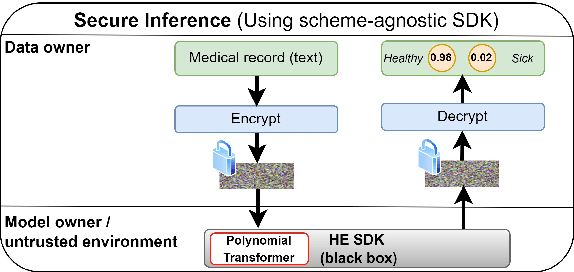

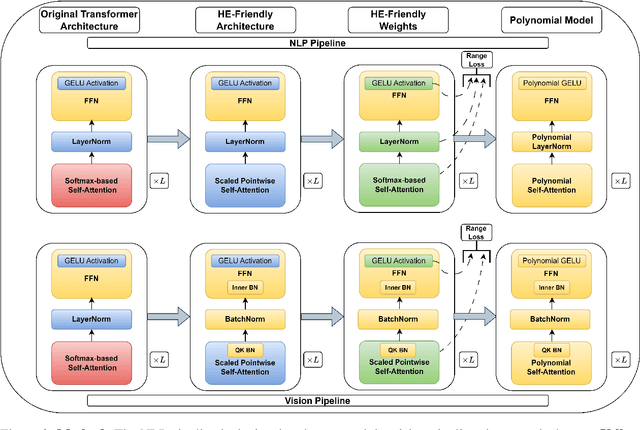

Abstract:Designing privacy-preserving deep learning models is a major challenge within the deep learning community. Homomorphic Encryption (HE) has emerged as one of the most promising approaches in this realm, enabling the decoupling of knowledge between the model owner and the data owner. Despite extensive research and application of this technology, primarily in convolutional neural networks, incorporating HE into transformer models has been challenging because of the difficulties in converting these models into a polynomial form. We break new ground by introducing the first polynomial transformer, providing the first demonstration of secure inference over HE with transformers. This includes a transformer architecture tailored for HE, alongside a novel method for converting operators to their polynomial equivalent. This innovation enables us to perform secure inference on LMs with WikiText-103. It also allows us to perform image classification with CIFAR-100 and Tiny-ImageNet. Our models yield results comparable to traditional methods, bridging the performance gap with transformers of similar scale and underscoring the viability of HE for state-of-the-art applications. Finally, we assess the stability of our models and conduct a series of ablations to quantify the contribution of each model component.
Sensitive Tuning of Large Scale CNNs for E2E Secure Prediction using Homomorphic Encryption
Apr 26, 2023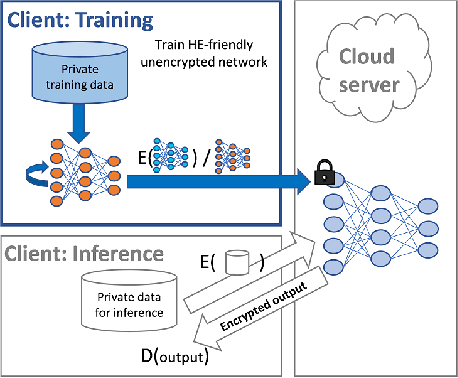
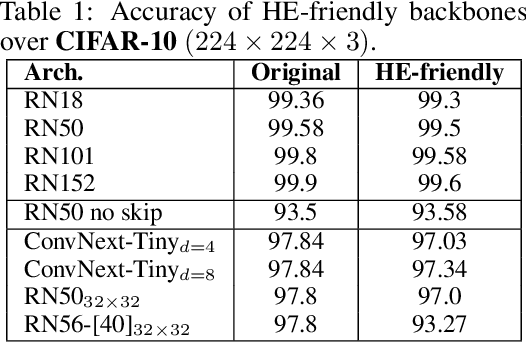
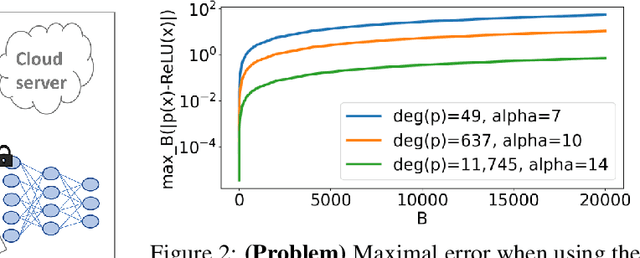
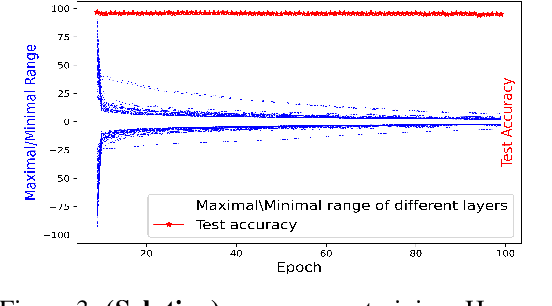
Abstract:Privacy-preserving machine learning solutions have recently gained significant attention. One promising research trend is using Homomorphic Encryption (HE), a method for performing computation over encrypted data. One major challenge in this approach is training HE-friendly, encrypted or unencrypted, deep CNNs with decent accuracy. We propose a novel training method for HE-friendly models, and demonstrate it on fundamental and modern CNNs, such as ResNet and ConvNeXt. After training, we evaluate our models by running encrypted samples using HELayers SDK and proving that they yield the desired results. When running on a GPU over the ImageNet dataset, our ResNet-18/50/101 implementations take only 7, 31 and 57 minutes, respectively, which shows that this solution is practical. Furthermore, we present several insights on handling the activation functions and skip-connections under HE. Finally, we demonstrate in an unprecedented way how to perform secure zero-shot prediction using a CLIP model that we adapted to be HE-friendly.
HE-PEx: Efficient Machine Learning under Homomorphic Encryption using Pruning, Permutation and Expansion
Jul 07, 2022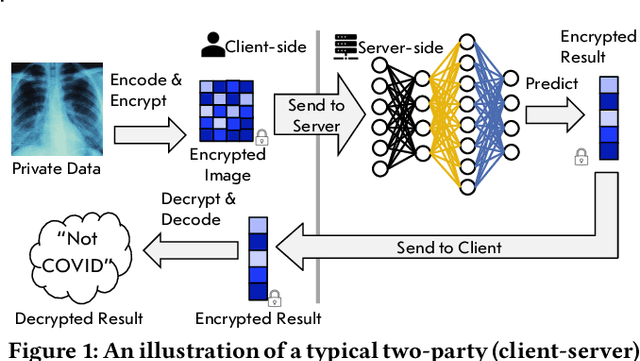
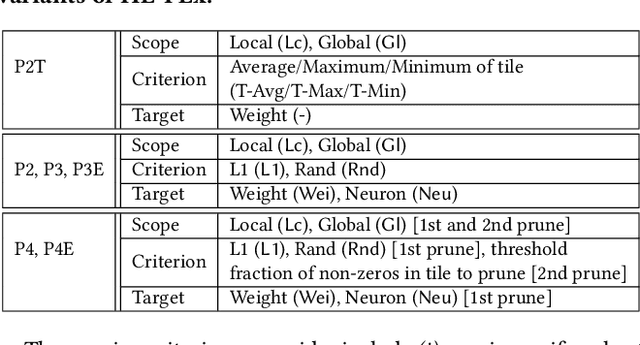


Abstract:Privacy-preserving neural network (NN) inference solutions have recently gained significant traction with several solutions that provide different latency-bandwidth trade-offs. Of these, many rely on homomorphic encryption (HE), a method of performing computations over encrypted data. However, HE operations even with state-of-the-art schemes are still considerably slow compared to their plaintext counterparts. Pruning the parameters of a NN model is a well-known approach to improving inference latency. However, pruning methods that are useful in the plaintext context may lend nearly negligible improvement in the HE case, as has also been demonstrated in recent work. In this work, we propose a novel set of pruning methods that reduce the latency and memory requirement, thus bringing the effectiveness of plaintext pruning methods to HE. Crucially, our proposal employs two key techniques, viz. permutation and expansion of the packed model weights, that enable pruning significantly more ciphertexts and recuperating most of the accuracy loss, respectively. We demonstrate the advantage of our method on fully connected layers where the weights are packed using a recently proposed packing technique called tile tensors, which allows executing deep NN inference in a non-interactive mode. We evaluate our methods on various autoencoder architectures and demonstrate that for a small mean-square reconstruction loss of 1.5*10^{-5} on MNIST, we reduce the memory requirement and latency of HE-enabled inference by 60%.
Fighting COVID-19 in the Dark: Methodology for Improved Inference Using Homomorphically Encrypted DNN
Nov 17, 2021

Abstract:Privacy-preserving deep neural network (DNN) inference is a necessity in different regulated industries such as healthcare, finance, and retail. Recently, homomorphic encryption (HE) has been used as a method to enable analytics while addressing privacy concerns. HE enables secure predictions over encrypted data. However, there are several challenges related to the use of HE, including DNN size limitations and the lack of support for some operation types. Most notably, the commonly used ReLU activation is not supported under some HE schemes. We propose a structured methodology to replace ReLU with a quadratic polynomial activation. To address the accuracy degradation issue, we use a pre-trained model that trains another HE-friendly model, using techniques such as "trainable activation" functions and knowledge distillation. We demonstrate our methodology on the AlexNet architecture, using the chest X-Ray and CT datasets for COVID-19 detection. Our experiments show that by using our approach, the gap between the F1 score and accuracy of the models trained with ReLU and the HE-friendly model is narrowed down to within a mere 1.1 - 5.3 percent degradation.
Tile Tensors: A versatile data structure with descriptive shapes for homomorphic encryption
Nov 03, 2020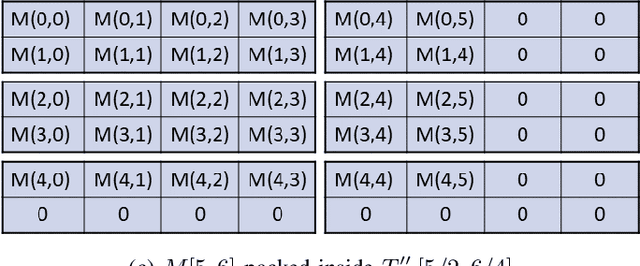
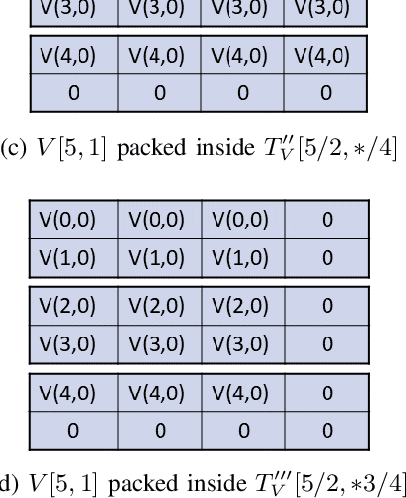
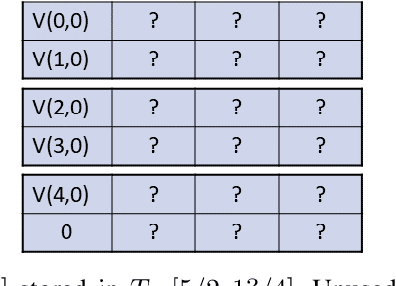
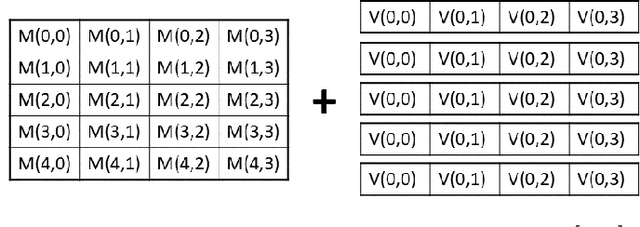
Abstract:Moving from the theoretical promise of Fully Homomorphic Encryption (FHE) to real-world applications with realistic and acceptable time and memory figures is an on-going challenge. After choosing an appropriate FHE scheme, and before implementing privacy-preserving analytics, one needs an efficient packing method that will optimize use of the ciphertext slots, trading-off size, latency, and throughput. We propose a solution to this challenge. We describe a method for efficiently working with tensors (multi-dimensional arrays) in a system that imposes tiles, i.e., fixed-size vectors. The tensors are packed into tiles and then manipulated via operations on those tiles. We further show a novel and concise notation for describing packing details. Our method reinterprets the tiles as multi-dimensional arrays, and combines them to cover enough space to hold the tensor. An efficient summation algorithm can then sum over any dimension of this construct. We propose a descriptive notation for the shape of this data structure that describes both the original tensor and how it is packed inside the tiles. Our solution can be used to optimize the performance of various algorithms such as consecutive matrix multiplications or neural network inference with varying batch sizes. It can also serve to enhance optimizations done by homomorphic encryption compilers. We describe different applications that take advantage of this data structure through the proposed notation, experiment to evaluate the advantages through different applications, and share our conclusions.
A Little Is Enough: Circumventing Defenses For Distributed Learning
Feb 16, 2019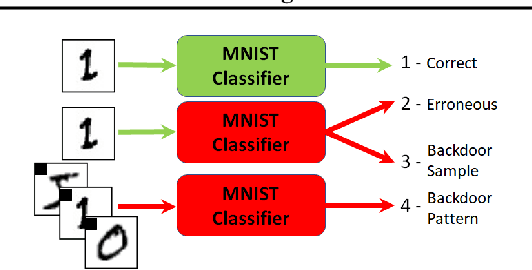

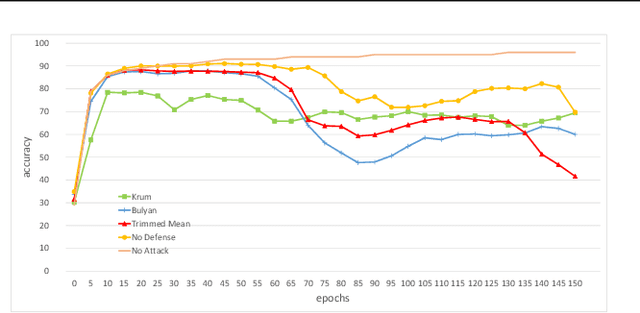
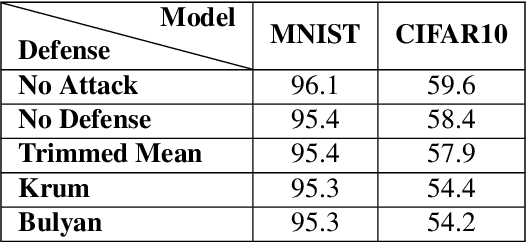
Abstract:Distributed learning is central for large-scale training of deep-learning models. However, they are exposed to a security threat in which Byzantine participants can interrupt or control the learning process. Previous attack models and their corresponding defenses assume that the rogue participants are (a) omniscient (know the data of all other participants), and (b) introduce large change to the parameters. We show that small but well-crafted changes are sufficient, leading to a novel non-omniscient attack on distributed learning that go undetected by all existing defenses. We demonstrate our attack method works not only for preventing convergence but also for repurposing of the model behavior (backdooring). We show that 20% of corrupt workers are sufficient to degrade a CIFAR10 model accuracy by 50%, as well as to introduce backdoors into MNIST and CIFAR10 models without hurting their accuracy
Deceiving End-to-End Deep Learning Malware Detectors using Adversarial Examples
May 13, 2018
Abstract:In recent years, deep learning has shown performance breakthroughs in many applications, such as image detection, image segmentation, pose estimation, and speech recognition. However, this comes with a major concern: deep networks have been found to be vulnerable to adversarial examples. Adversarial examples are slightly modified inputs that are intentionally designed to cause a misclassification by the model. In the domains of images and speech, the modifications are so small that they are not seen or heard by humans, but nevertheless greatly affect the classification of the model. Deep learning models have been successfully applied to malware detection. In this domain, generating adversarial examples is not straightforward, as small modifications to the bytes of the file could lead to significant changes in its functionality and validity. We introduce a novel loss function for generating adversarial examples specifically tailored for discrete input sets, such as executable bytes. We modify malicious binaries so that they would be detected as benign, while preserving their original functionality, by injecting a small sequence of bytes (payload) in the binary file. We applied this approach to an end-to-end convolutional deep learning malware detection model and show a high rate of detection evasion. Moreover, we show that our generated payload is robust enough to be transferable within different locations of the same file and across different files, and that its entropy is low and similar to that of benign data sections.
 Add to Chrome
Add to Chrome Add to Firefox
Add to Firefox Add to Edge
Add to Edge